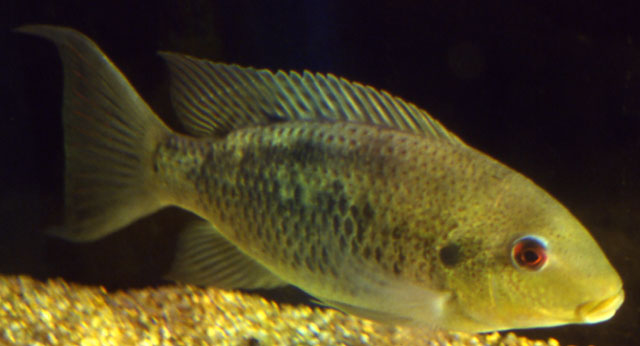| Cichlidae (Cichlids), subfamily: Pseudocrenilabrinae |
| 15.6 cm SL (male/unsexed) |
|
demersal; freshwater |
| Africa: Corubal River system in Guinea Bissau to the Saint Paul's River in western Liberia. |
|
Dorsal spines (total): 15-16; Dorsal soft rays (total): 12-14; Anal spines: 3-3; Anal soft rays: 11-13; Vertebrae: 30-31. Diagnosis: mouth small; 3 full rows of scales on cheek (Ref. 2, 53405). Preorbital bone deep; toothed area of lower pharyngeal bone heart-shaped with slender, bevelled teeth with no minor cusp (Ref. 2). Caudal fin strongly emarginated (Ref. 53405). Fold of skin above upper lip bright yellow in life; margins of dorsal, caudal and anal fins black (Ref. 2).
Description: outer jaw teeth bicuspid, inner jaw teeth tricuspid, posterior teeth on pharyngeal bone bicuspid; micro-gillrakers present; scales cycloid (Ref. 53405). Pelvic fins remarkably elongated; elongated rays in upper and lower caudal fin lobe give it a bifurcated appearance (Ref. 52307).
Coloration: in life: sides silvery with yellow-orange spot on each scale; lower part of head white; skin above upper lip light yellow; dorsal, anal and caudal fins black-edged; "tilapian" spot on dorsal fin present in young individuals, but smaller and more irregular than that of S. occidentalis (Ref. 53405). 4 dark bars may sometimes be visible (Ref. 52307). |
| Foraging behaviour reported as sifting of the bottom with the downward-orientated mouth (Ref. 52307). |
|
Least Concern (LC); Date assessed: 10 January 2020 Ref. (130435)
|
| harmless |
Source and more info: www.fishbase.org. For personal, classroom, and other internal use only. Not for publication.
